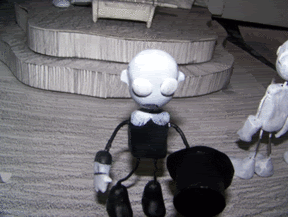to make it happen.
But I also had to find a statement from another artist; something I planned to do anyways because what better information to take down than whatever comes straight from the horse's mouth?
I'm going to post, before my statement {which will likely cower in comparison}, the artist statement{s} that I found for one artist that still inspires my work.
“I am interested in a political art, that is to say an art of ambiguity, contradiction, uncompleted gestures and uncertain ending – an art (and a politics) in which optimism is kept in check, and nihilism at bay.”
On living a lifetime in Johannesburg: “I have never been able to escape Johannesburg, and in the end, all my work is rooted in this rather desperate provincial city. I have never tried to make illustrations of apartheid, but the drawings and the films are certainly spawned by, and feed off, the brutalised society left in its wake.”
On his drawings: “The drawings don’t start with ‘a beautiful mark’. It has to be a mark of something out there in the world. It doesn’t have to be an accurate drawing, but it has to stand for an observation, not something that is abstract, like an emotion.”
Quotations from William Kentridge by Carolyn Christov-Bakargiev (1998), Societé des Expositions du Palais de Beaux-Arts de Bruxelles.
So! Here goes something...When I was a child, I was often scolded for my constant daydreaming. I was smart and scatterbrained simultaneously, and when I could not keep my thoughts and my imaginings in my head I would make them tangible. If I had pencils, I would draw them. If I had clay, I would make them. Sometimes they were characters; the people I wished I could be. Sometimes, they were friends and foes that I didn't have in reality. I have not changed in all these years, though my focus has not remained the same. Now I imagine likelier scenarios to save myself from being lost in worlds that do not exist. Such became the subject of my latest work, involving my current fascination with the apocalypse. I can't keep myself entertained by the mundane that surrounds me in my life. I have to imagine a time or place of action, or I grow bored and weary of the real world, and it leads to the fear that I am ill prepared to live that life for the next thirty-plus years. My work is often an outlet of my imagination, or a plane where I can keep my many worlds recorded somewhere public, rather than privately stored in my mind. I've always been partial to sharing what I have in abundance.
Printmaking and stop motion allows me to take my time in recreating these worlds. I can fashion them with the same care and attention that I use when I think them up. I'm always reshaping and fixing the scenario to make someone or something fit--to make it legitimate--so I felt that my choices of media made the most sense. The certain styles I'm attracted to, like expressionist forms and stark, simple structures, I like to incorporate into my work, as most of the influences in style that I have been exposed to and absorbed came from all the horror movies I used to watch as a child. In time I am sure my own style will evolve from my current fixations, but until then, the work I make is still a combination of many old tricks from many old dogs.
To this day, I am still a daydreamer. I cannot keep myself entertained by the mundane that surrounds my life, so I imagine a more exciting place with interesting people, creating an avatar for myself to navigate these worlds. Since I could pick up a pencil and draw, I would try to reproduce images of the 'people' I would meet, or the 'places' I would go. Many of these worlds were born from nightmares I would have as a child, having been exposed to many of the 80s and 90s horror films since I was four. Later, they were born of the fantasies I would read in books or watch on television. As I grew older, I forced myself to restrain my imagination and think of more realistic worlds were more interesting things still happened. This restriction has lead me to my current focus, and that is my fascination of an apocalyptic world.
I chose printmaking and stop motion to be the mediums of my choice because I felt that they allowed me to create my latest world most effectively. With the process of creating prints I can draw up the plane as I do in my mind, and with the stop motion I can bring it to life as it plays through my imagination. I have always been fond of sharing what I had in abundance, so it only makes sense that I wish to share this world with others.
Still long. Why am I so verbose?

